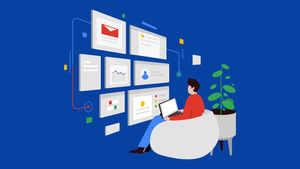Table of contents
Notebook LM
- Opening research up with AI
Gallery walks
- What’s a gallery walk?
- Setting one up
Research immersion walls
- What’s a research immersion wall?
- Why it works
- Setting one up
- War rooms
Graffiti walls
- What’s a graffiti wall
- Setting one up
- Making it useful
Collaborative synthesis activities
- Immediate post-session synthesis
- Structured note-taking
- Synthesis buddies
- Affinity mapping
- Template-driven analysis
- Empathy mapping
- Multi-session synthesis
Research is valuable, but teams often struggle to engage with it after a readout or deck. To make insights stick, we need ways to immerse people in them. Digital tools like Notebook LM create interactive notebooks that enable teams to query research directly and efficiently. Gallery walks allow people to engage with insights in an active way, while immersion walls and war rooms transform findings into a living, shared space that remains visible over time. Graffiti walls gather candid, anonymous input, and collaborative synthesis activities ensure that teams make sense of raw data together through techniques such as post-session recaps, affinity mapping, and empathy mapping. Together, these approaches make research an experience that teams can share.
Research is only as valuable as the impact it has on your team. Yet too often, findings get buried in a slide deck or report. If we want to gain insights that inform decisions and spark new ideas, we need more engaging ways to share them. That can mean opening research up in a digital space, where teams can query and explore it with AI tools like Notebook LM. Alternatively, it can mean bringing research into the physical environment through gallery walks, immersion walls, or even full-scale war rooms, allowing people to interact with it directly. What follows are practical approaches to help teams get closer to research.
Think of these as building blocks rather than strict recipes. You can adapt, mix, or recombine them to suit your team and project.
Notebook LM
Opening research up with AI
Before exploring physical methods like gallery walks or research immersion walls, it’s worth considering a digital-first option: Notebook LM, Google’s AI-powered research assistant.
At its core, Notebook LM lets you create a “notebook” powered by Google’s Gemini 1.5 Pro model. Think of each notebook as its own mini language model, trained only on the sources you’ve uploaded. That might include your own research notes and transcripts, or external materials such as articles, PDFs, YouTube videos, or even audio files.
Google Notebook LM
Once your sources are in, Notebook LM can summarize them, generate timelines, create FAQs, or produce audio overviews. Even more powerful, your team can ask direct questions of the notebook, and every answer comes with citations linking back to the exact part of the original material. In practice, this makes large and complex bodies of research easier to navigate, especially for teammates who don’t have the time (or appetite) to comb through raw data themselves.
Notebook LM lowers the barrier to engagement and turns research into something people can interact with anytime, anywhere. Instead of a static deck or buried documents, you have a living, searchable research companion, one that helps your team surface insights, make connections, and carry findings into their day-to-day decisions.
From here, let’s look at physical ways to bring research into the room and make it something your team can walk through, see, and interact with together.
Gallery walks
Let your team walk through insights
When you’ve spent weeks deep in interviews, focus groups, and surveys, it can be hard to bring your team into the richness of your findings. A report or slide deck can only go so far, and people might not engage with it. What makes research stick is when people feel and experience it; when they step into the world of your users themselves.
That’s where gallery walks come in.
What’s a gallery walk?
Gallery walks originated in education as an active learning technique that encourages students to move through stations and engage with artifacts together. Designed to spark collaboration and critical thinking, these qualities make them valuable in research, balancing depth, efficiency, and inclusivity so that every voice is heard and patterns emerge collectively.
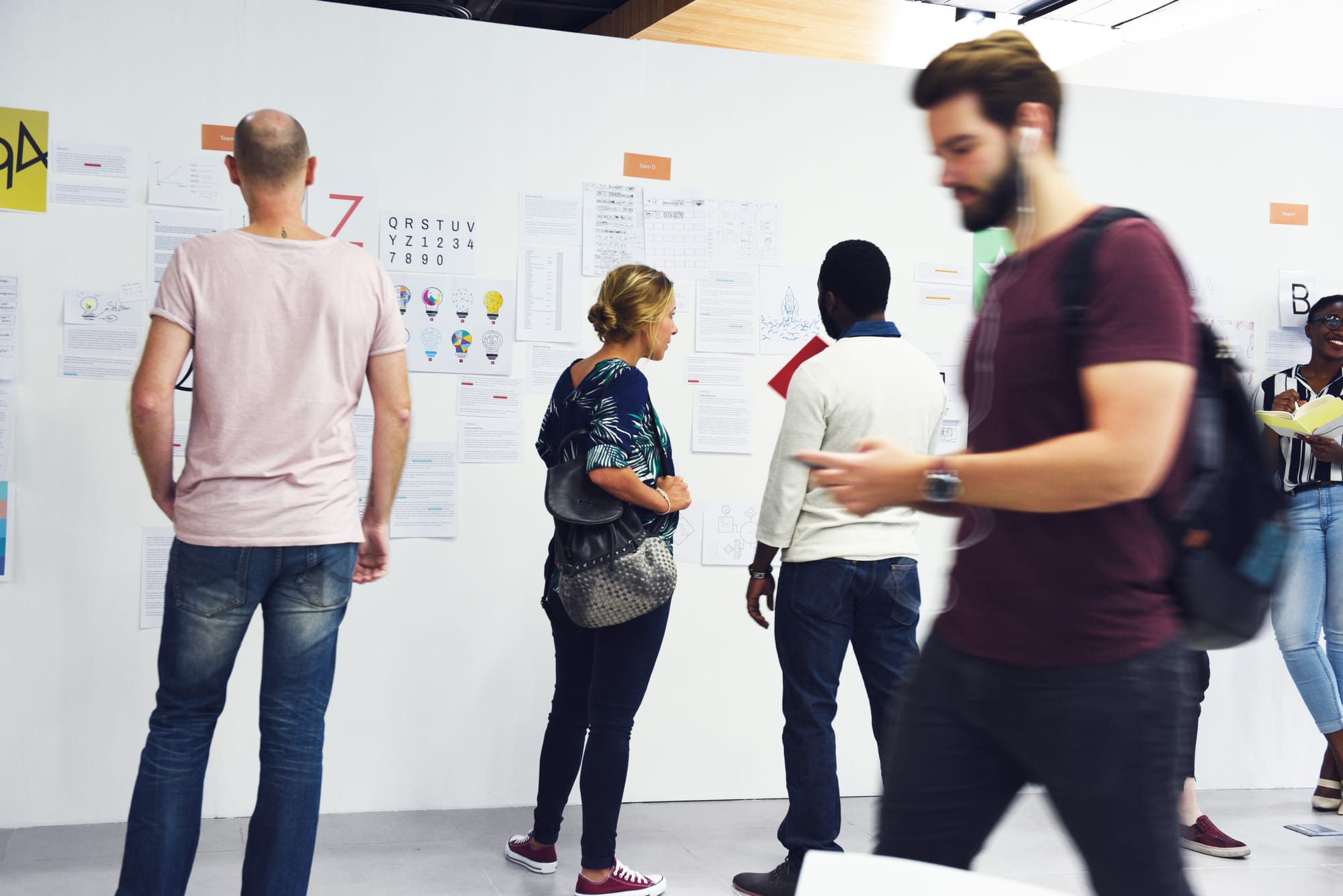
In research, the same principle applies. Rather than telling people what you found, you invite them to experience it. Insights are displayed as posters or artifacts arranged around the room, much like a gallery. Teams rotate through each station, adding notes, discussing what they see, and building on one another’s thoughts.
You usually set up six (or a number that suits you) stations, each dedicated to a specific theme or topic. Posters can include quotes, images, or guiding prompts. Groups spend 15–20 minutes at a station, writing notes on sticky notes, sketching connections, or discussing it out loud. Conversations are often recorded, and the sticky notes capture individual reflections alongside group debates.
Unlike a simple readout, it’s an active, collective synthesis where personal perspectives and shared meaning merge.
Setting one up
You don’t need much to run a gallery walk, but a little planning goes a long way.
- Pick four to six themes, each framed as an open-ended question.
- Create stations with posters, whiteboards, or printed artifacts that include images and prompts.
- Gather materials such as sticky notes, markers, and audio recorders if you plan to capture discussions.
- Arrange the stations around the room so small groups of three to five people can gather without crowding.
- Give teams 15–20 minutes per station, then rotate and encourage them to read and build on earlier annotations.
As a facilitator, your role is to keep things moving, answer questions, and encourage participation, rather than leading the content itself. The power comes from participants engaging directly with the material.
Finally, have each group return to their starting station to see how their ideas have evolved. Then bring everyone together for a whole-room debrief. This is where the magic often happens: themes connect, patterns emerge, and the group begins to see the bigger story.
Research immersion walls
Turning research into living, shared memory
One of the hardest parts of conducting research isn’t just collecting valuable insights; it’s ensuring they remain part of the team’s day-to-day thinking. Some projects go on for weeks or months. Decks and reports that communicate findings are great, but people sometimes overlook them, and they can be challenging to interact with. A research immersion wall allows for a permanent or semi-permanent living space for research.
What’s a research immersion wall?
A research immersion wall is akin to a gallery walk that never ends. A space like this enables you to display quotes, photos, findings, and questions in one large area. Over time, the wall becomes a shared map of what you’ve learned, something the whole team can walk up to, navigate, and add to.
Spaces like this work because our brains remember locations and spatial layouts far better than we remember lists or slides. When we correlate information to a physical spot, we can recall it more easily and see new connections between ideas. In cognitive science, this is referred to as a “spatial memory extension.” It’s the same principle behind memory palaces, where people remember information by placing it in imagined rooms. Here, the wall is the room.
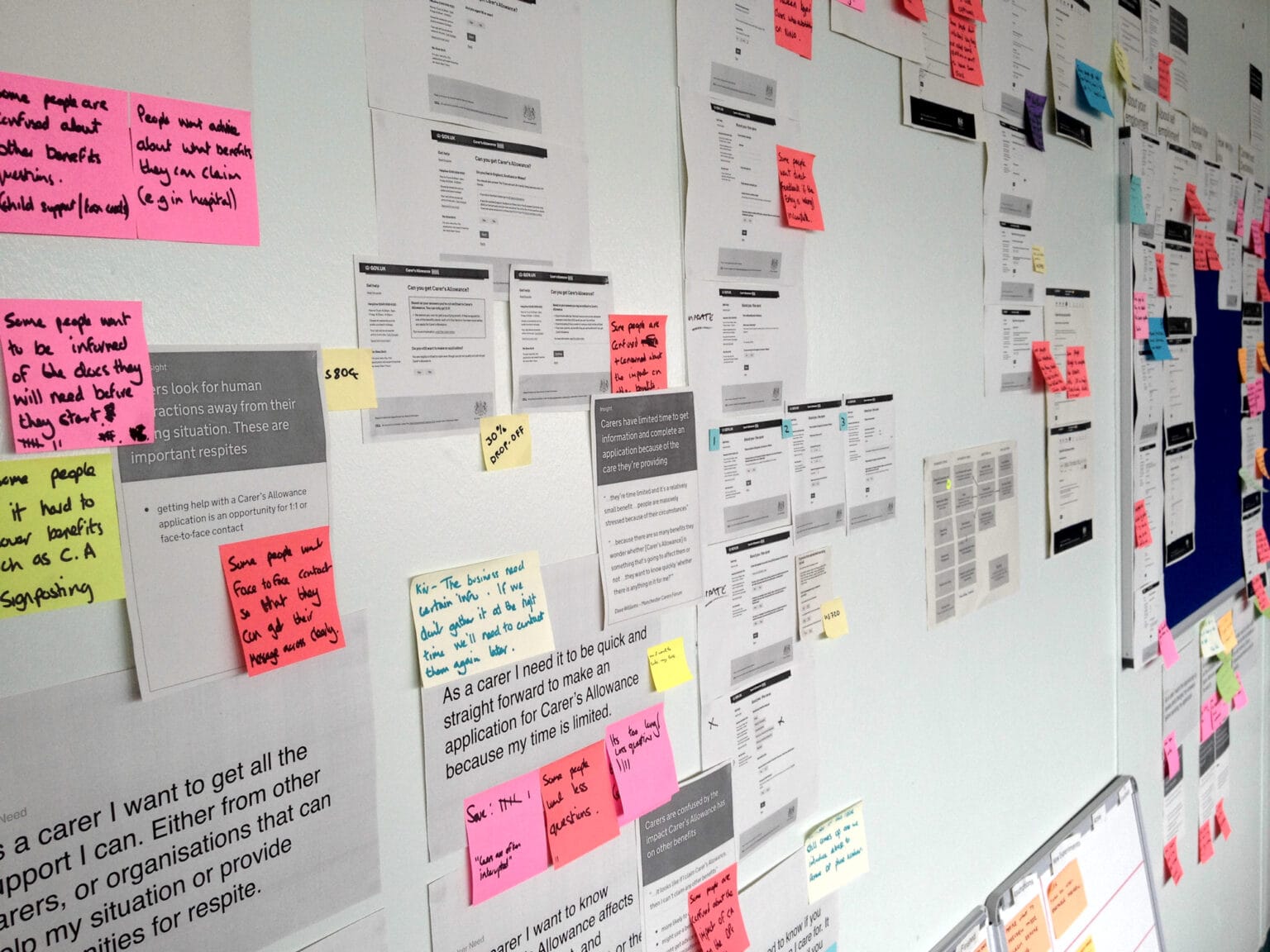
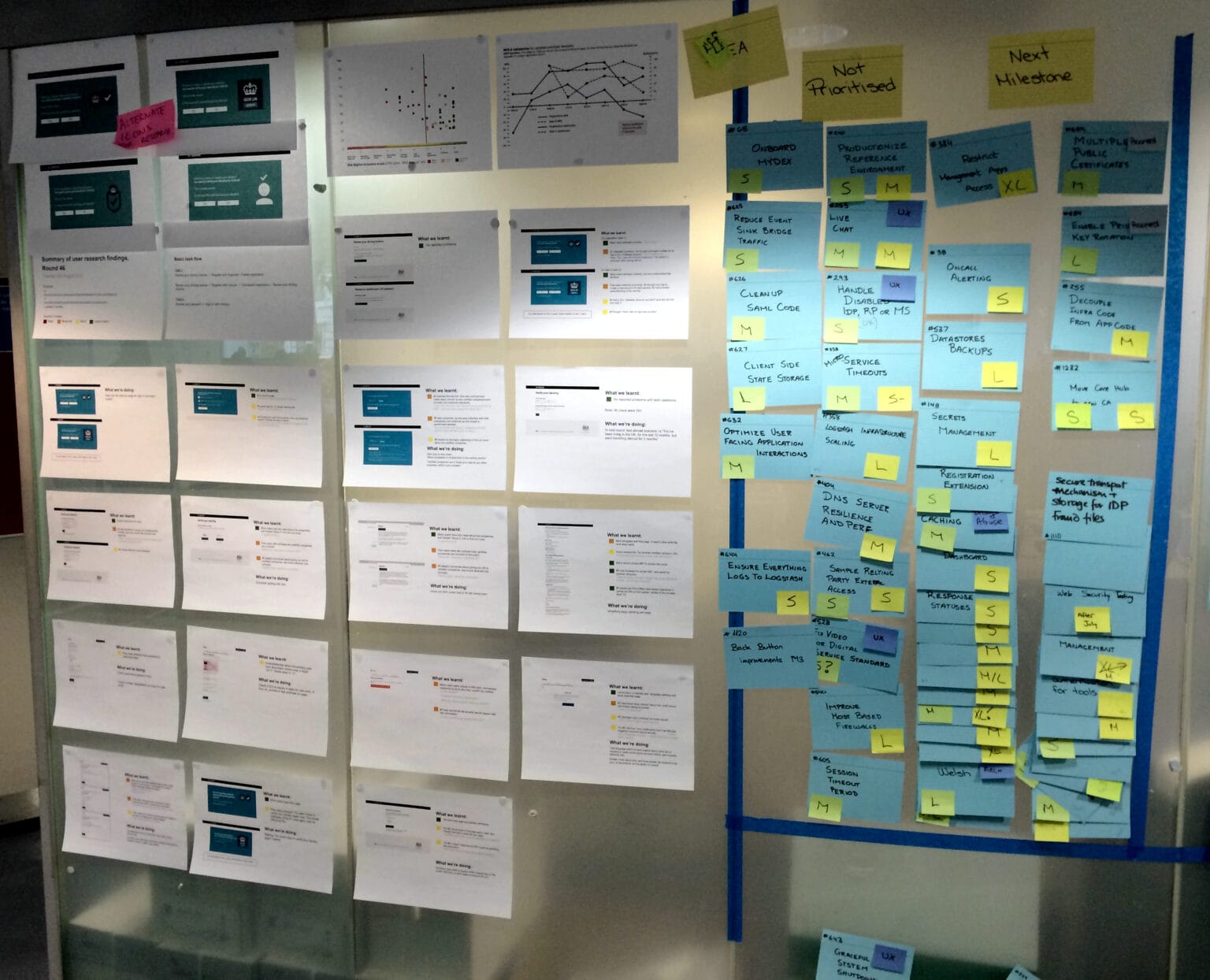
Images courtesy of gds.blog.gov.uk
Why it works
Our short-term memory is limited. We can juggle maybe seven things at once. But our spatial memory can handle much more. A research wall offloads that burden: instead of keeping every detail in your head, you place it in the room where everyone can see it.
This has two big effects. First, it reduces cognitive load, freeing the team’s mental energy for higher-level thinking. Second, it makes patterns easier to spot when related insights sit near each other on a wall; connections almost jump out at you.
Setting one up
You don’t need a perfect setup to start.
A blank wall, a few foam boards, or even portable whiteboards can do the trick. What matters most is creating enough surface area to hold a wide range of insights and making it easy to update over time.
Some quick tips:
- Keep core insights at eye level, with supporting evidence nearby and raw data lower down
- Use colors, clusters, and arrows to show relationships
- Mix formats: quotes, stats, photos, journey maps, for variety and clarity
- Refresh regularly with new findings and reorganize as patterns shift
A wall can act as a hub for synthesis sessions, like an extended gallery walk. You can run small-group discussions around different sections, encourage annotations with sticky notes, or dot-vote to highlight what feels most important. Some teams even rotate “wall stewards,” so responsibility for keeping it fresh doesn’t fall on just one person.
And if you need a digital bridge, QR codes or photos of the wall can link back to more comprehensive datasets or help track its evolution over time.
War rooms
Some teams extend immersion walls into full war rooms, transforming an entire space into a project hub. Every wall provides insights and context, so the moment you step inside, you’re surrounded by the research and drawn into the work.
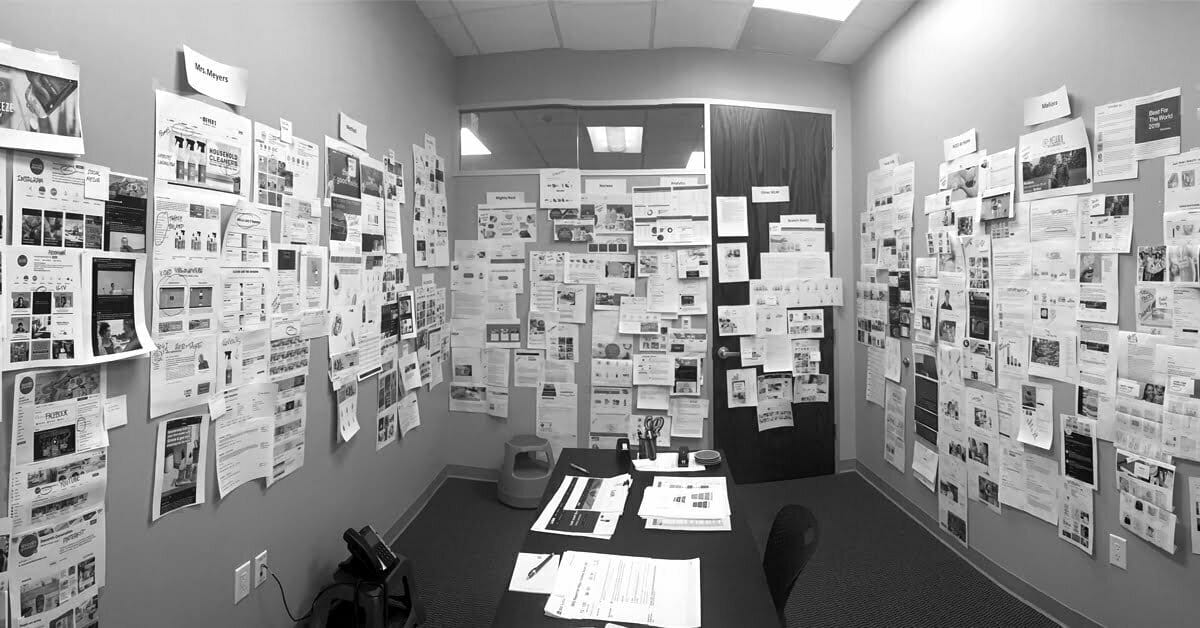
Graffiti walls
Gathering candid input creatively
Unlike gallery walks or immersion walls, which help teams engage with research they already have, graffiti walls are a research collection method. They’re designed to gather fresh input directly from participants in an open, anonymous, and creative way.
What’s a graffiti wall?
A graffiti wall is a temporary public canvas where people can stop, reflect, and respond to a prompt. Instead of formal interviews or surveys, you invite participants to write, sketch, or draw their thoughts directly on a shared surface. Because contributions are anonymous and playful, you often get feedback that feels more honest and unfiltered than in structured sessions.

The power of graffiti walls lies in their accessibility.
They reduce social pressure, making it easy for anyone to share an opinion quickly. Anonymity lowers barriers, which means you’re more likely to capture candid thoughts, frustrations, moments of delight, or new ideas that might otherwise stay hidden. They’re not designed to replace more in-depth methods, such as interviews or observations, but they work well as a supplementary technique to stretch research budgets and engage broader audiences.
Setting one up
Start with one clear, open-ended prompt such as “When using our product, I hate it when…” or “What’s one thing you’d most like to see improved?” Place your canvas in a high-traffic area where your target audience feels comfortable stopping. Attach pens, markers, or sticky notes directly to the wall, and include simple instructions that encourage both writing and drawing. Bright materials and sample responses help people overcome the blank wall effect.
Making it useful
Graffiti walls need light facilitation. A friendly nudge to participate or a starter question can spark momentum. Over time, the wall fills with varied responses, creating a visual record of many voices. To preserve the input, photograph the wall regularly, both close-ups and full views, before it’s taken down. Later, cluster similar responses to identify patterns and themes. Because the data is anonymous, analysis focuses on content rather than demographics, surfacing needs and pain points that can guide deeper follow-up.
Collaborative synthesis activities
Before a team can be immersed in research, the findings themselves need to be clear. Raw notes, transcripts, and recordings on their own are overwhelming and fragmented. Collaborative synthesis activities are how we turn that raw material into shared understanding. By working together to spot themes, cluster insights, and challenge interpretations, teams create patterns they can trust and build a stronger foundation for the immersive methods that follow.
Immediate post-session synthesis
- Right after a research session, spend 15 minutes as a group capturing insights. Begin by recalling key takeaways from memory for a few minutes, then review notes for details and quotes. This ensures impressions are fresh and nothing critical gets lost.
Structured note-taking
- Assign clear roles during research: one person conducts the interview, while another takes detailed notes in a shared document. This prevents information silos and allows the team to spot patterns as they emerge.
Synthesis buddies
- Pair people from different disciplines, for example, a designer with a PM. Buddies review findings together, identify themes, and challenge each other’s interpretations. This surfaces perspectives one discipline alone might miss.
Affinity mapping
- Have everyone jot down one observation per sticky note (physical or digital), then group them collaboratively into clusters. Discuss and refine clusters until they form clear, actionable themes. Use this when you need to make sense of large sets of observations.
Template-driven analysis
- Use predefined categories or codes based on your research goals (like “decision-making” or “pain points”). Apply these to your data, then adjust as new themes appear. This provides structure while staying flexible.
Template-driven analysis
- Use a four-quadrant framework, what users say, do, think, and feel, to organize insights. Run short, silent brainstorming rounds to avoid groupthink, then cluster and discuss the ideas. Empathy maps are most effective when you want to establish a shared understanding of user motivations and context.
Multi-session synthesis
- Instead of analyzing after every single session, gather insights after every three to six sessions. This helps teams see bigger patterns and prevents fatigue. Stop when the same findings keep surfacing, which signals research saturation.
Working collaboratively on this project ensures that the group considers multiple perspectives and gives the entire team a stronger connection to the findings. Collaborative synthesis activities offer lightweight, structured approaches to transform scattered observations into a shared understanding, ranging from brief post-session recaps to more in-depth mapping workshops.
Immersing teams in research isn’t about replacing reports or decks, but rather making research more immersive, interesting, and interactive. Whether through gallery walks, immersion walls, war rooms, graffiti walls, or collaborative synthesis, these practices transform findings into an experience that teams share. When research becomes part of the environment, it stays alive in people’s minds, guiding decisions long after the initial readout is over.

